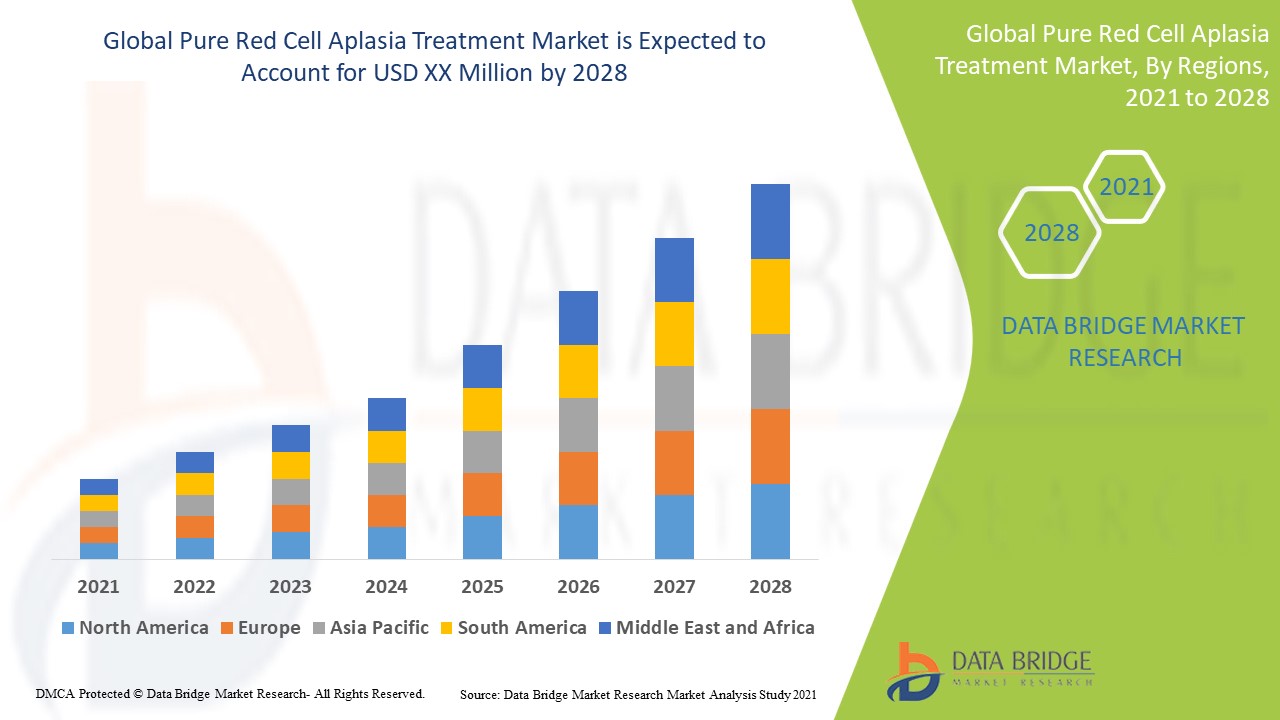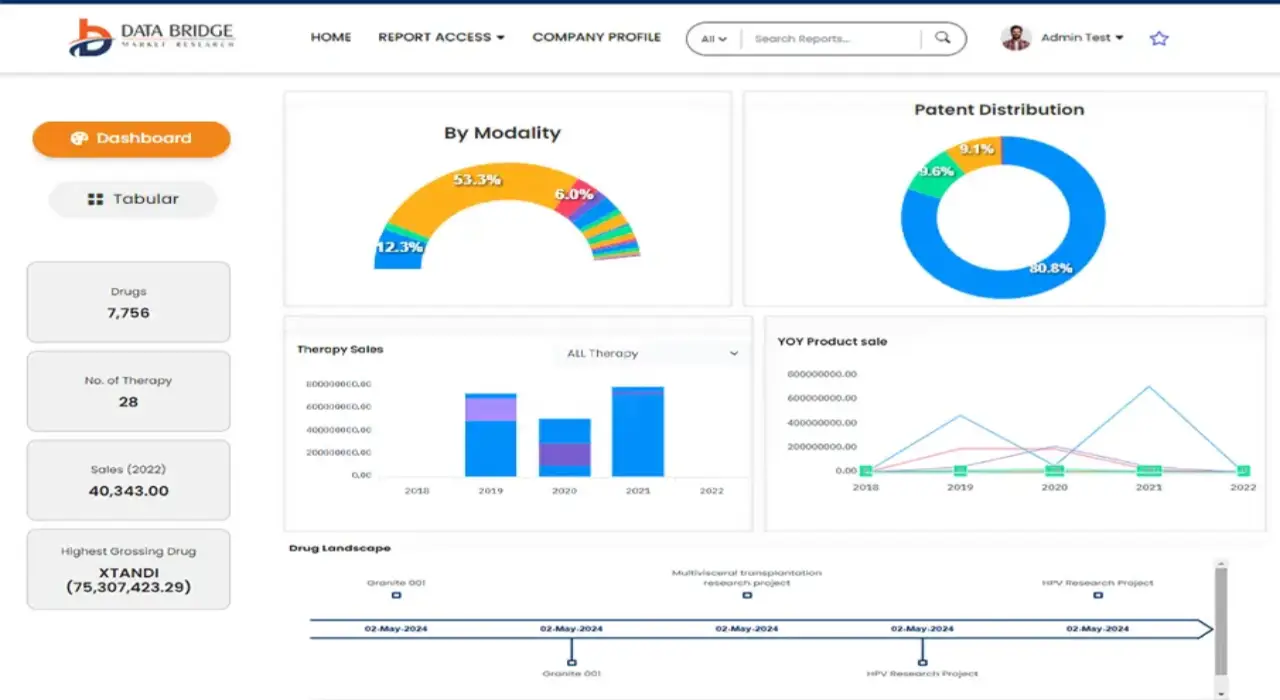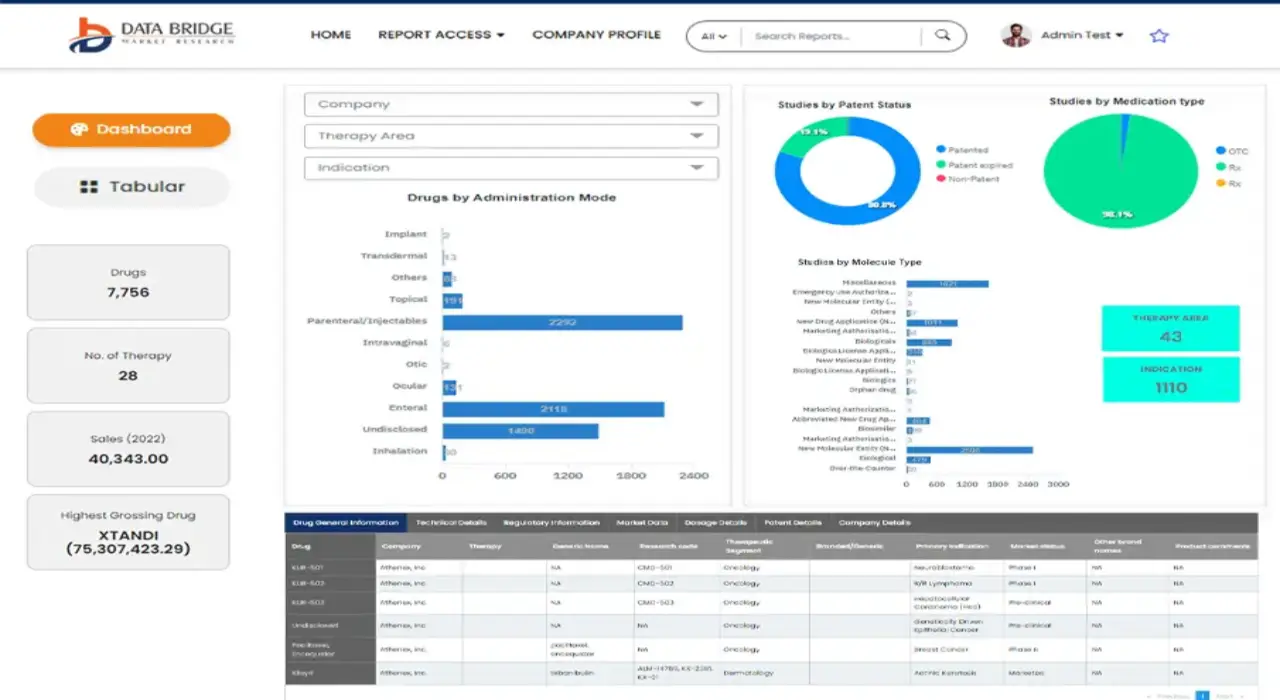Global Pure Red Cell Aplasia Treatment Market
Market Size in USD Million
CAGR :
% 
 USD
460.32 Million
USD
896.55 Million
2024
2032
USD
460.32 Million
USD
896.55 Million
2024
2032
| 2025 –2032 | |
| USD 460.32 Million | |
| USD 896.55 Million | |
|
|
|
|
Global Pure Red Cell Aplasia Treatment Market Segmentation, By Type (Acquired Pure Red Cell Aplasia, Congenital Pure Red Cell Aplasia, and Transient Pure Red Cell Aplasia), Treatment (Corticosteroids, Immunosuppressant, Non-steroidal anti-inflammatory drugs (NSAIDS), Immunoglobulins, Blood Transfusion, Chelation Therapy, and Others), Diagnosis (Blood Tests, Physical Examination, Biopsy, CT Scan, and Others), Dosage (Tablet, Injection, and Others), Route of Administration (Oral, Intravenous, and Others), Symptoms (Fatigue, Shortness of breath, Pale Skin, Dizziness, and Others), End-Users (Clinic, Hospital, and Others), Distribution Channel (Hospital Pharmacy, Retail Pharmacy, and Online Pharmacy) – Industry Trends and Forecast to 2032
Pure Red Cell Aplasia Treatment Market Analysis
The pure red cell aplasia treatment market focuses on managing this rare disorder characterized by a significant reduction in red blood cell production. The market encompasses treatments such as corticosteroids, immunosuppressants, immunoglobulins, and blood transfusions, tailored to the underlying cause—acquired, congenital, or transient. Recent advancements include targeted therapies and novel immunosuppressive agents, enhancing treatment efficacy and patient outcomes. Major players, including Pfizer Inc., Sanofi, and Novartis AG, are actively developing innovative solutions to address unmet clinical needs. Increasing awareness, advancements in diagnostics, and a growing prevalence of autoimmune and viral conditions driving acquired cases are bolstering market growth. Distribution through hospital pharmacies and online platforms ensures accessibility. However, challenges such as limited treatment options for congenital cases and high treatment costs persist. The future outlook is optimistic, with ongoing research and development likely to expand the therapeutic landscape, offering improved quality of life for affected individuals.
Pure Red Cell Aplasia Treatment Market Size
The global pure red cell aplasia treatment market size was valued at USD 460.32 million in 2024 and is projected to reach USD 896.55 million by 2032, with a CAGR of 8.69% during the forecast period of 2025 to 2032. In addition to the insights on market scenarios such as market value, growth rate, segmentation, geographical coverage, and major players, the market reports curated by the Data Bridge Market Research also include depth expert analysis, patient epidemiology, pipeline analysis, pricing analysis, and regulatory framework.
Pure Red Cell Aplasia Treatment Market Trends
“Awareness in Rare Hematological Condition”
The pure red cell aplasia treatment market is witnessing growth driven by advancements in therapeutics and increasing awareness of this rare hematological condition. The disorder, characterized by a selective failure of red blood cell production, has spurred innovation in immunosuppressive therapies, targeted treatments, and supportive care options such as immunoglobulins and blood transfusions. A notable trend is the adoption of biologics and monoclonal antibodies, offering enhanced efficacy in managing autoimmune-related cases. With rising diagnostic accuracy and expanding access to treatments, the market is poised for steady growth, improving outcomes for patients worldwide.
Report Scope and Pure Red Cell Aplasia Treatment Market Segmentation
|
Attributes |
Pure Red Cell Aplasia Treatment Key Market Insights |
|
Segments Covered |
|
|
Countries Covered |
U.S., Canada and Mexico in North America, Germany, France, U.K., Netherlands, Switzerland, Belgium, Russia, Italy, Spain, Turkey, Rest of Europe in Europe, China, Japan, India, South Korea, Singapore, Malaysia, Australia, Thailand, Indonesia, Philippines, Rest of Asia-Pacific (APAC) in the Asia-Pacific (APAC), Saudi Arabia, U.A.E., South Africa, Egypt, Israel, Rest of Middle East and Africa (MEA) as a part of Middle East and Africa (MEA), Brazil, Argentina and Rest of South America as part of South America. |
|
Key Market Players |
AbbVie Inc. (U.S.), Merck & Co Inc. (U.S.), Pfizer Inc. (U.S.), GSK plc (U.K.), Sanofi (France), Cipla (India), AstraZeneca (U.K.), Johnson & Johnson Services, Inc. (U.S.), Viatris Inc. (U.S.), Teva Pharmaceutical Industries Ltd. (Israel), Astellas Pharma Inc. (Japan), Bristol-Myers Squibb Company (U.S.), Novartis AG (Switzerland), Accord Healthcare (U.K.), F. Hoffmann-La Roche Ltd. (Switzerland), Abbott (U.S.), Bayer AG (Germany), Sumitomo Corporation (Japan), Merck KGaA (Germany), LEO Pharma A/S (Denmark), Bausch Health Companies Inc. (Canada), Assertio Holdings, Inc. (U.S.), Boehringer Ingelheim International GmbH (Germany) |
|
Market Opportunities |
|
|
Value Added Data Infosets |
In addition to the insights on market scenarios such as market value, growth rate, segmentation, geographical coverage, and major players, the market reports curated by the Data Bridge Market Research also include depth expert analysis, patient epidemiology, pipeline analysis, pricing analysis, and regulatory framework. |
Pure Red Cell Aplasia Treatment Market Definition
Pure red cell aplasia is a rare hematological disorder characterized by a severe reduction or absence of red blood cell production in the bone marrow, while other blood cell lineages remain unaffected. It can be congenital, acquired, or transient, with causes ranging from autoimmune diseases, viral infections, and certain medications to genetic abnormalities. Treatment typically involves addressing the underlying cause, with options including corticosteroids, immunosuppressants, blood transfusions, and immunoglobulin therapy.
Pure Red Cell Aplasia Treatment Market Dynamics
Drivers
- Increasing Prevalence of Autoimmune Disorders
Autoimmune conditions, where the immune system mistakenly attacks the body’s own cells, are a significant cause of acquired pure red cell aplasia (PRCA). In these cases, the immune system targets and destroys red blood cell precursors in the bone marrow, leading to anemia. As the prevalence of autoimmune diseases such as systemic lupus erythematosus and rheumatoid arthritis rises, there is an increased demand for immunosuppressive therapies to manage PRCA. This growing need for effective treatments directly drives the market for PRCA therapies, particularly immunosuppressants and biologics. Consequently, this trend accelerates market growth as patients seek options to mitigate the impact of autoimmune-driven PRCA.
- Innovations in Biologics and Monoclonal Antibodies
Innovations in biologics and monoclonal antibodies have revolutionized the treatment landscape for pure red cell aplasia (PRCA), offering more targeted and personalized therapies. These advanced treatments are designed to specifically target the underlying immune mechanisms responsible for PRCA, resulting in improved efficacy and fewer side effects compared to traditional treatments. Monoclonal antibodies, in particular, are highly effective in modulating immune responses, especially in autoimmune-related PRCA. As research progresses and new biologic therapies are introduced, patients benefit from more tailored treatment options that increase the likelihood of positive outcomes. This innovation-driven shift is a key market driver, propelling the growth of the PRCA treatment market.
Opportunities
- Adoption of Next-Generation Diagnostics
Enhanced diagnostic tools, such as genetic testing and advanced molecular diagnostics, are pivotal in the early detection of pure red cell aplasia (PRCA). These tools allow for more accurate identification of the disease, particularly in its rare and often challenging forms. Early diagnosis enables timely intervention, improving patient outcomes and increasing the demand for effective PRCA treatments. As healthcare systems continue to adopt these advanced diagnostic technologies, more patients are likely to be diagnosed earlier, driving the need for therapeutic solutions. This shift toward early detection represents a significant market opportunity, accelerating the growth of the PRCA treatment market.
- Improved Treatment Accessibility
The growth of online pharmacies and hospital networks plays a crucial role in enhancing the distribution channels for pure red cell aplasia (PRCA) treatments. With the increasing digitalization of healthcare, patients now have easier access to medications and treatments through online platforms, overcoming geographical and logistical barriers. Hospital networks are expanding globally, providing better healthcare access, particularly in underserved areas. This increased accessibility ensures that more patients can receive timely and effective treatments for PRCA. The expansion of these distribution channels presents a significant market opportunity, enabling pharmaceutical companies to reach a broader patient base and driving the growth of the PRCA treatment market.
Restraints/Challenges
- Limited Treatment Options for Rare Forms
For congenital or severe cases of pure red cell aplasia (PRCA), treatment options remain limited, presenting a significant challenge to the market. While therapies such as immunosuppressants and blood transfusions are commonly used, they are not universally effective for all patients, particularly those with rare genetic forms of the disease. The lack of targeted treatments for these specific cases means that many patients face limited or inadequate therapeutic options, which can result in poor outcomes and a lower quality of life. This gap in treatment availability hinders market growth, as the demand for more effective and personalized therapies remains unmet.
- High Treatment Costs
Advanced therapies, including biologics and immunosuppressants, often come with high costs, which can be a significant market restraint, particularly in low-income regions or countries with limited healthcare infrastructure. The expensive nature of these treatments creates financial barriers for many patients, limiting their access to essential care. In countries where healthcare systems are underfunded or lack sufficient insurance coverage, the affordability of these therapies becomes a critical issue. This high cost also affects healthcare providers, who may struggle to offer these treatments to a broader patient base, thus hindering the overall market potential and limiting growth opportunities in these regions.
This market report provides details of new recent developments, trade regulations, import-export analysis, production analysis, value chain optimization, market share, impact of domestic and localized market players, analyses opportunities in terms of emerging revenue pockets, changes in market regulations, strategic market growth analysis, market size, category market growths, application niches and dominance, product approvals, product launches, geographic expansions, technological innovations in the market. To gain more info on the market contact Data Bridge Market Research for an Analyst Brief, our team will help you take an informed market decision to achieve market growth.
Pure Red Cell Aplasia Treatment Market Scope
The market is segmented on the basis of type, treatment, diagnosis, dosage, route of administration, symptoms, end users, and distribution channel. The growth amongst these segments will help you analyse meagre growth segments in the industries and provide the users with a valuable market overview and market insights to help them make strategic decisions for identifying core market applications.
Type
- Acquired Pure Red Cell Aplasia
- Congenital Pure Red Cell Aplasia
- Transient Pure Red Cell Aplasia
Treatment
- Corticosteroids
- Immunosuppressants
- Non-steroidal Anti-Inflammatory Drugs
- Immunoglobulins
- Blood Transfusion
- Chelation Therapy
- Others
Diagnosis
- Blood Tests
- Physical Examination
- Biopsy
- CT Scan
- Others
Dosage
- Tablet
- Injection
- Others
Route of Administration
- Oral
- Intravenous
- Others
Symptoms
- Fatigue
- Shortness of Breath
- Pale Skin
- Dizziness
- Others
End-Users
- Clinic
- Hospital
- Others
Distribution Channel
- Hospital Pharmacy
- Retail Pharmacy
- Online Pharmacy
Pure Red Cell Aplasia Treatment Market Regional Analysis
The market is analysed and market size insights and trends are provided by country, type, treatment, diagnosis, dosage, route of administration, symptoms, end users, and distribution channel as referenced above.
The countries covered in the market report are U.S., Canada and Mexico in North America, Germany, France, U.K., Netherlands, Switzerland, Belgium, Russia, Italy, Spain, Turkey, Rest of Europe in Europe, China, Japan, India, South Korea, Singapore, Malaysia, Australia, Thailand, Indonesia, Philippines, Rest of Asia-Pacific (APAC) in the Asia-Pacific (APAC), Saudi Arabia, U.A.E., South Africa, Egypt, Israel, Rest of Middle East and Africa (MEA) as a part of Middle East and Africa (MEA), Brazil, Argentina and Rest of South America as part of South America.
North America dominates the pure red cell aplasia treatment market, driven by the presence of major pharmaceutical companies and a high prevalence of anemia. The region benefits from a strong healthcare infrastructure, enabling faster approval and commercialization of new treatments. In addition, the well-established healthcare system supports widespread access to innovative therapies, contributing to market dominance.
The Asia-Pacific region is anticipated to experience significant growth from 2025 to 2032, driven by advancements in treatment and diagnostic technologies. Increased research and development efforts, along with growing investments in the healthcare sector, are further propelling market expansion. In addition, the rising number of domestic pharmaceutical companies in the region is contributing to the increased availability of treatment options and market growth.
The country section of the report also provides individual market impacting factors and changes in regulation in the market domestically that impacts the current and future trends of the market. Data points such as down-stream and upstream value chain analysis, technical trends and porter's five forces analysis, case studies are some of the pointers used to forecast the market scenario for individual countries. Also, the presence and availability of global brands and their challenges faced due to large or scarce competition from local and domestic brands, impact of domestic tariffs and trade routes are considered while providing forecast analysis of the country data.
Pure Red Cell Aplasia Treatment Market Share
The market competitive landscape provides details by competitor. Details included are company overview, company financials, revenue generated, market potential, investment in research and development, new market initiatives, global presence, production sites and facilities, production capacities, company strengths and weaknesses, product launch, product width and breadth, application dominance. The above data points provided are only related to the companies' focus related to market.
Pure Red Cell Aplasia Treatment Market Leaders Operating in the Market Are:
- AbbVie Inc. (U.S.)
- Merck & Co Inc, (U.S.)
- Pfizer Inc. (U.S.)
- GSK plc (U.K.)
- Sanofi (France)
- Cipla (India)
- AstraZeneca (U.K.)
- Johnson & Johnson Services, Inc. (U.S.)
- Viatris Inc. (U.S.)
- Teva Pharmaceutical Industries Ltd. (Israel)
- Astellas Pharma Inc. (Japan)
- Bristol-Myers Squibb Company (U.S.)
- Novartis AG (Switzerland)
- Accord Healthcare (U.K.)
- F. Hoffmann-La Roche Ltd. (Switzerland)
- Abbott (U.S.)
- Bayer AG (Germany)
- Sumitomo Corporation (Japan)
- Merck KGaA (Germany)
- LEO Pharma A/S (Denmark)
- Bausch Health Companies Inc. (Canada)
- Assertio Holdings, Inc. (U.S.)
- Boehringer Ingelheim International GmbH (Germany)
SKU-
Get online access to the report on the World's First Market Intelligence Cloud
- Interactive Data Analysis Dashboard
- Company Analysis Dashboard for high growth potential opportunities
- Research Analyst Access for customization & queries
- Competitor Analysis with Interactive dashboard
- Latest News, Updates & Trend analysis
- Harness the Power of Benchmark Analysis for Comprehensive Competitor Tracking
Research Methodology
Data collection and base year analysis are done using data collection modules with large sample sizes. The stage includes obtaining market information or related data through various sources and strategies. It includes examining and planning all the data acquired from the past in advance. It likewise envelops the examination of information inconsistencies seen across different information sources. The market data is analysed and estimated using market statistical and coherent models. Also, market share analysis and key trend analysis are the major success factors in the market report. To know more, please request an analyst call or drop down your inquiry.
The key research methodology used by DBMR research team is data triangulation which involves data mining, analysis of the impact of data variables on the market and primary (industry expert) validation. Data models include Vendor Positioning Grid, Market Time Line Analysis, Market Overview and Guide, Company Positioning Grid, Patent Analysis, Pricing Analysis, Company Market Share Analysis, Standards of Measurement, Global versus Regional and Vendor Share Analysis. To know more about the research methodology, drop in an inquiry to speak to our industry experts.
Customization Available
Data Bridge Market Research is a leader in advanced formative research. We take pride in servicing our existing and new customers with data and analysis that match and suits their goal. The report can be customized to include price trend analysis of target brands understanding the market for additional countries (ask for the list of countries), clinical trial results data, literature review, refurbished market and product base analysis. Market analysis of target competitors can be analyzed from technology-based analysis to market portfolio strategies. We can add as many competitors that you require data about in the format and data style you are looking for. Our team of analysts can also provide you data in crude raw excel files pivot tables (Fact book) or can assist you in creating presentations from the data sets available in the report.













